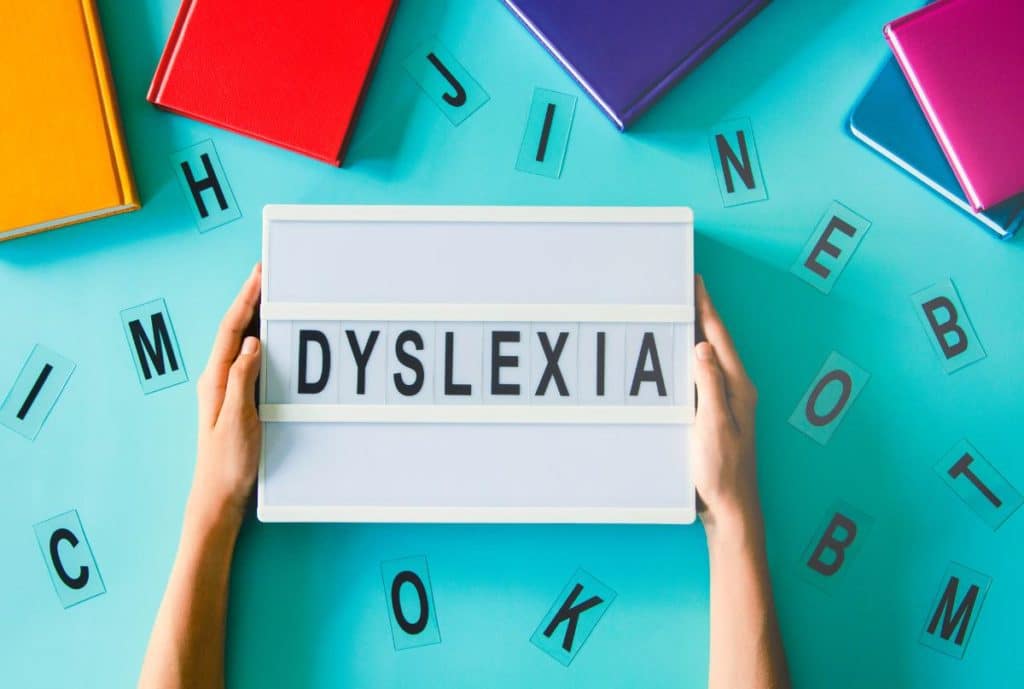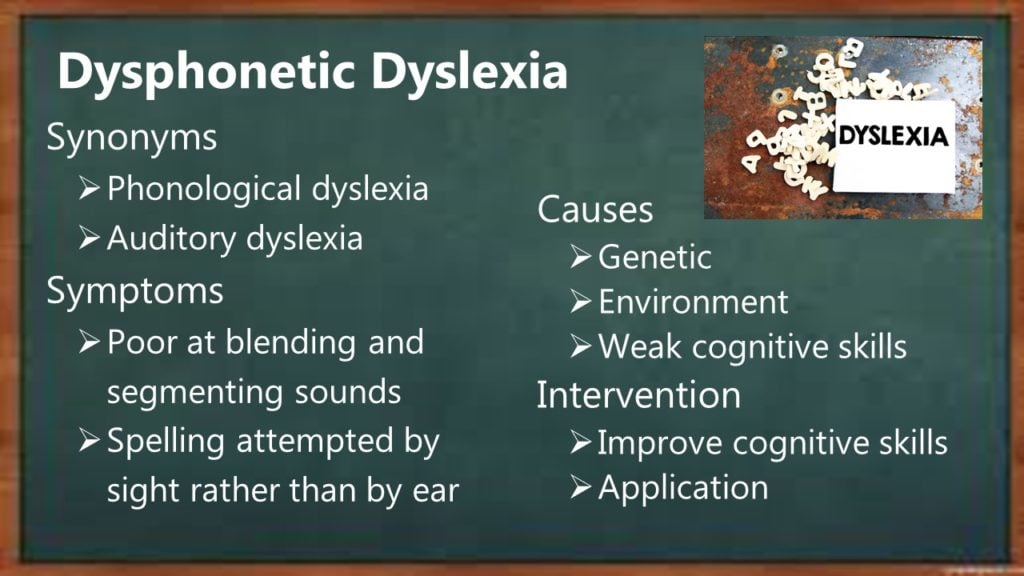
Dyslexia is a common concern as it affects many children and adults. And although no two dyslexics have exactly the same symptoms, there are key symptoms which you can, quite easily, pick up.
The terms ‘dysphonetic’ and ‘dyseidetic’ are words used to describe typical symptoms of dyslexia. Reading difficulties related to phonological processing weaknesses have been called dysphonetic dyslexia, phonological dyslexia, or auditory dyslexia.
Children with dysphonetic dyslexia tend to have good visual processing skills but have difficulty remembering letter sounds, analyzing the individual sounds in words, and blending sounds into words.
Symptoms of dysphonetic dyslexia
Reading and spelling patterns of children with dysphonetic dyslexia include:
- Poor ability to remember individual sounds or sequences of sounds.
- Difficulty blending individual sounds into words.
- Difficulty listening to words and omitting one sound and substituting it for another (say cat; now take off the /c/ and put on an /f/).
- Difficulty remembering the sounds that individual letters and phonetically regular and irregular letter combinations represent.
- Inability to rapidly retrieve letter sounds while analyzing words so that the beginning of the word is forgotten by the time the last letter of the word is recalled (naming problem).
- Difficulty analyzing unknown words because of poor knowledge of phonetic rules and difficulty sequencing sounds.
- Difficulty applying the phonetic rules from words that can be read to pseudowords that follow the same pattern but are not actual words.
- Vowel sounds are particularly troublesome.
- Word substitutions that are conceptually (person, human) or visually (horse, house) related but not phonetically related.
- Limited sight vocabulary because the student cannot memorize an abundance of words without the benefit of phonetic cues.
- Guessing at unfamiliar words rather than employing word-analysis skills.
- Spelling remains below reading level because it is attempted by sight rather than by ear.
- Correct spellings occur primarily on words the child has encountered repeatedly and can, therefore, be revisualized.
- Bizarre spellings that seldom can be identified, even by the child, because they do not follow phonetic patterns.
- Extraneous letters and omitted syllables in spelling.
Causes of dysphonetic dyslexia
Although some causes of dyslexia have a genetic origin (Kere, 2014) and environmental factors play an important role (Stein, 2018), cognition mediates brain-behavior relationships and, therefore, offers a sufficient level of explanation for developing principled interventions. We thus need to understand the cognitive difficulties that underpin reading failure, regardless of whether their origin is constitutional or environmental (Elliott & Grigorenko, 2014).
We cannot address dyslexia without an understanding that learning is a stratified process: one step must be mastered well enough before subsequent steps can be learned. This means that there is a sequence involved in learning. It is like climbing a ladder; you will fall if you miss one of the ladder’s rungs. If you miss out on one of the important steps in the learning process, you cannot master subsequent steps.
A simple and practical example is that one has to learn to count before it becomes possible to learn to add and subtract. If one tries to teach a child to add and subtract before they have been taught to count, one will quickly discover that no amount of effort will ever succeed in teaching the child these skills.
This principle is also of great importance on the sports field. If we go to a soccer field to watch the coach at work, we shall soon find that he spends much time drilling his players in basic skills, like heading, passing, dribbling, and kicking. The players most proficient at these basic skills usually turn out to be the best when playing in soccer games.
In the same way, a child must acquire specific skills and knowledge first, before it becomes possible to become a good reader.
To understand what causes dysphonetic dyslexia, we must focus on the cognitive skills underpinning language-related functions. Cognitive skills of importance include — but are not limited to — phonological awareness and verbal short-term memory.
- Phonological awareness refers to an individual’s awareness of the phonological structure — or sound structure — of language. It is a listening skill that includes distinguishing speech units, such as rhymes, syllables in words, and individual phonemes in syllables.
- Verbal short-term memory involves the recall of words or verbal items. Verbal short-term memory capacity, as measured by digit span or non-word repetition, is typically reduced in children with dyslexia, and this reduction is still present in adults with a history of dyslexia.
Treatment of dysphonetic dyslexia
The good news is that weaknesses in foundational skills can be attacked head-on; it is possible to strengthen these cognitive skills through training and practice. Edublox’s Development Tutor aims at strengthening underlying cognitive skills, including verbal short-term and working memory.
In addition, Edublox’s Live Tutor aims to help children with dyslexia catch up in reading and spelling. Classes are aligned with the Orton Gillingham approach but target the brain’s visual word form area simultaneously. Therefore, they develop decoding and fluency.
Book a free consultation to discuss your child’s learning needs after watching the video below.
.
Dysphonetic dyslexia – key takeaways

Authored by Sue du Plessis (B.A. Hons Psychology; B.D.), an educational specialist with 30+ years’ experience in the field of learning disabilities.
References and souces:
Elliott, J. G., & Grigorenko, E. L. (2014). The dyslexia debate. Cambridge: Cambridge University Press.
Kere, J. (2014). The molecular genetics and neurobiology of developmental dyslexia as model of a complex phenotype. Biochemical and Biophysical Research Communications, 452(2), 236-243.
Smith, C. R. (1991). Learning disabilities: The interaction of learner, task, and setting. Boston: Allyn and Bacon.
Stein, J. (2018). The magnocellular theory of developmental dyslexia. In T. Lachmann, & T. Weis (Eds.). Reading and dyslexia (pp. 97-128). Cham, Switzerland: Springer.


